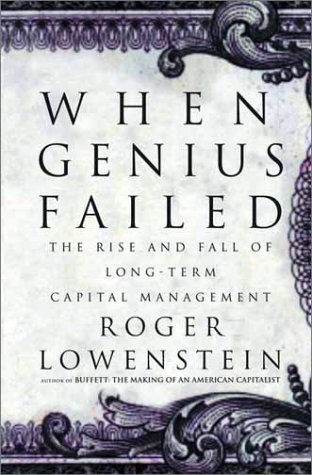More on this book
Community
Kindle Notes & Highlights
Read between
October 4 - October 8, 2022
Long-Term’s debacle was a tragedy for its partners. Motivated by insatiable greed, they had forcibly cashed out their outside investors only months before, leaving themselves to withstand, virtually alone, the brunt of the collapse. The wizards of Wall Street personally lost $1.9 billion. Larry Hilibrand, the most cocksure of traders, who had previously been worth close to half a billion dollars, awoke to discover that he was broke.
Recapitalized with a fresh $3.65 billion, Long-Term continued to plummet, like a parachutist who yanks the rip cord but keeps falling anyway. In its first two weeks, the consortium lost $750 million. It was happening again—for the consortium, the scariest of all possible epilogues.
Sandy Weill came out on top, as he always seemed to. Citicorp and Travelers/Salomon merged on schedule. Lehman Brothers, which had been plagued by rumors, quickly recovered. Chase Manhattan—without whose repeated help Long-Term would have surely failed—had its loans repaid and came out whole. Indeed, thanks to the rescue, Long-Term met every margin call. All of its debts to creditors were repaid in full.
No stigma was attached; second acts on Wall Street are as common as they are in politics.
They had been done in, they argued, by an unforeseeable event—a perfect storm such as strikes once in a hundred years. “I believe that,” Rosenfeld explained after the crash. “I do think it was something that never happened before.”10 Of course, it had happened, not once in a hundred years but many times—in Mexico, on Wall Street, in stocks, in bonds, in silver, in Thailand, in Russia, in Brazil. People caught in such financial cataclysms typically feel singularly unlucky, but financial history is replete with examples of “fat tails”—unusual and extreme price swings that, based on a reading of
...more
Though Wall Street recovered, Long-Term’s brand of arbitrage did not. Under its new owners, the fund enjoyed a good last quarter in 1998 and a good start to the new year; then it went into a tailspin. In the summer of 1999, U.S. swap spreads once again ballooned, to 112 points—wider, even, than at the astronomical height of the previous year’s panic. The once-in-a-century flood had struck twice in two years.
So Long-Term’s problem had not been just illiquidity. Perhaps the fund’s entire strategy had been wrong, and the world’s (and Long-Term’s) perception of credit in 1998 had been a little too rosy. The evidence suggests that both factors were at work: Long-Term misjudged the markets, and the effect of that misjudgment was sorely compounded in September, when—to protect themselves against Long-Term’s imminent collapse—other traders went on strike and “liquidity” disappeared.
Greenspan’s more serious and longer-running error has been to consistently shrug off the need for regulation and better disclosure with regard to derivative products.
Moreover, aside from improving reporting on derivatives, there is a strong argument to be made for restricting actual exposure. Regulators limit the amount that Chase Manhattan and Citibank can lend, so that their loans do not exceed a certain ratio of capital. The regulators do this for good reason: banks have repeatedly shown that they will exceed the limits of prudence if they can. Why, then, does Greenspan endorse a system in which banks can rack up any amount of exposure that they choose—as long as that exposure is in the form of derivatives?
No investment—Internet wunderkinds included—can be judged on the basis of half a cycle alone.
Long-Term put supreme trust in diversification—one of the shibboleths of modern investing, but an overrated one. As Keynes noted, one bet soundly considered is preferable to many poorly understood.
The professors overlooked the fact that people, traders included, are not always reasonable. This is the true lesson of Long-Term’s demise. No matter what the models say, traders are not machines guided by silicon chips; they are impressionable and imitative; they run in flocks and retreat in hordes.
On Wall Street, though, few lessons remain learned.
All that began to change when the United States, in 1971, went off the gold standard and the world adopted floating exchange rates. This bold liberalization dovetailed with a trend toward loosening trade restrictions. With both more goods and more dollars crossing borders, central banks were forced into an accommodative role; their task (however much they denied it) was increasingly to preserve an equilibrium in international currency flows. In lay terms, they had to keep markets quiet, or that was the goal. In time, it was unclear whether a global trader such as George Soros was adapting to
...more
Even after the market seizures of 1998, a regulatory cabal of Greenspan, Robert Rubin, Larry Summers, and Arthur Levitt stifled regulation of derivatives (a strange response to a crisis steeped in derivatives, to say the least).


